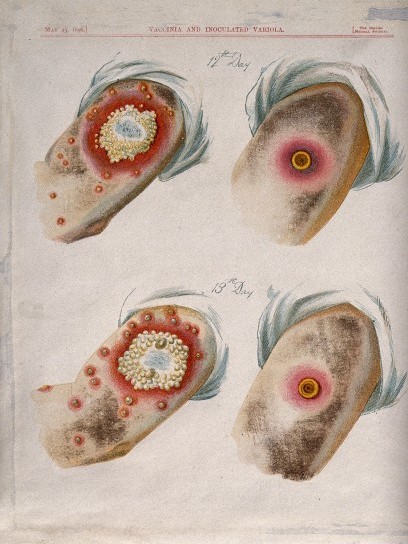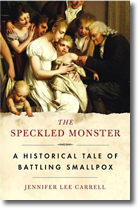Messy Miracles
The 12th and 13th Days
Chromolithograph (1896) after a painting by George Kirtland
Wellcome Library, London
Grotesque, But Better than Smallpox
Just about anything is better than getting full-blown smallpox.
Variolation — the forerunner of vaccination — resulted in pocks sprouting all over the site, often an upper arm, centering on a particularly nasty cluster that might stretch six inches across. It left a scar the size of a fist.
Smallpox vaccination, on the other hand, sometimes left dimpled scars about the diameter of a quarter. (I used to have one, but it’s disappeared.)
The Terms: Inoculation, Variolation, Vaccination
Inoculation is the practice of introducing a small amount of viral matter into the body (usually through the skin) in order to prime the immune system to recognize and destroy that virus. It is a preventative measure, not a cure.
- Inoculations essentially make the body a tiny bit sick (usually locally), in order to guard against major future infections.
Variolation (pronounced vuh-RYE-oh-lay-shun) is inoculation specifically against smallpox using live smallpox virus, variola major.
- This is the procedure brought to the attention of Western science by Lady Mary Wortley Montagu and Zabdiel Boylston in 1721.
- Previously, it had been practiced in China, Turkey, and West Africa.
- Throughout The Speckled Monster, I refer to variolation as “inoculation.”
- The term variolation comes from the scientific name of the smallpox virus, variola major, which in turn comes from varius, Latin for “spotted.”
- Variolation is no longer practiced. (Do I need to say that?) It quickly fell out of favor following Edward Jenner’s success with vaccination in 1796. In the wake of smallpox’s eradication, variolation is now impossible. You need live smallpox virus, and thankfully there isn’t any.
Vaccination, in its original and most precise usage, means inoculation against smallpox using the related but far less dangerous vaccinia (or cowpox) virus.
- The name vaccinia comes from vacca, Latin for “cow.”
- Edward Jenner began experimenting with vaccination in 1796.
- “Vaccination” has since become a generic term (like “Xerox” or “Kleenex”), and is now often used to indicate inoculation against any disease.
- You CANNOT get smallpox from the smallpox vaccine. It contains no smallpox virus. See the CDC’s Smallpox Vaccine Basics.
The Odds
- Variolation once killed an estimated 1 in 100 patients: good odds, when your only other choice was to suffer through an epidemic that might kill 1 in 3 of its victims.
- The modern smallpox vaccination kills about 1 or 2 in a million people: an almost miraculous improvement. No vaccine, however, is entirely without risk.
All About Smallpox: Next
Talking about risk…









With all due respect, after talking all around the subject, you did not provide a distinct definition of the difference between ‘variolation’ and ‘vaccination’, generically or specifically in the context of smallpox. I’ll keep looking.
Hi Ted,
Hmmm, I thought I was pretty clear:
Variolation (pronounced vuh-RYE-oh-lay-shun) is inoculation against smallpox using live smallpox virus, variola major.
Vaccination, in its original and most precise usage, means inoculation against smallpox using the related, but far less dangerous vaccinia (or cowpox) virus…. “Vaccination” has since become a generic term (like “Xerox,” “Kleenex,” and “Levi’s”), and is now often used to indicate inoculation against any disease.
Best,
Jennifer
What have you been reading, Ted?
Thanks for the post, Jennifer.
I find it deeply disturbing that you do not mention the contributions of Onesimus, the enslaved African man who introduced the practice of smallpox inoculation (variolation) to the American colonies in 1721. While Lady Mary Wortley Montagu absolutely played an important role in bringing variolation to England after observing it in the Ottoman Empire, she was not the sole or even the earliest source of this knowledge. Variolation had long been practiced in West Africa, Asia, and the Ottoman world, and it was Onesimus who provided the knowledge that led to the first organized inoculation campaign in North America during the Boston smallpox epidemic. Leaving him out presents an incomplete history and continues the pattern of overlooking the significant scientific and public health contributions of African and African-diaspora communities.
Hi Claire, Onesimus is the focus of two chapters in my book The Speckled Monster: “Curiosities of Smallpox” and “Caging the Monster.” It is impossible to distill the whole book into each and every post on the website, however. If you read the book, I hope you will see that I do not credit either Zabdiel Boylston or Lady Mary Wortley Montagu with inventing variolation or with being its source, but with bringing it to the attention of British science: at risk to their own reputations and occasionally safety. I spend a fair amount of ink tracing their knowledge to Turkish women (via Lady Mary’s sojourn in the city then known as Constantinople) and West African culture (via Onesimus and other enslaved Africans in Boston). I would also like to note that I wrote The Speckled Monster across 2002: I believe I was fairly early in bringing attention to Onesimus’s contributions, which I discovered through a fair amount of original archival research. It was not, in 2002, widely known: nor were the contributions of Boylston and Lady Mary. Twenty-odd years on, I would write the Boston sections of my book differently, focusing more attention and credit on the contributions of Africans: but that book, like all books, is a product of its time, and of the facts and perspectives that were available to me as I wrote it. I hope you will give it a chance.